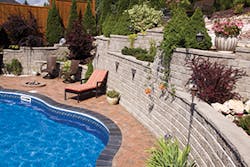Editor’s note: This article first appeared in the November/December 2015 edition of Erosion Control.
Retaining walls have evolved over the past 20 years. The choice of different types of walls for a variety of situations has expanded. Knowing the strengths and advantages of each type is a crucial part of any project incorporating walls. One type of wall might be the perfect solution for a challenging project, while in the next location, another type is the best choice.
The locations of retaining wall projects have also expanded. Many projects were once in large highway construction areas, such as bridges and grade separations. Now retaining walls are seen in all sorts of commercial locations, as well as in residential neighborhoods. Homeowners are needing walls to increase usable space in their yards, while many commercial projects are built on what land remains unused, even with the difficulties of hills or cliffs marking the location.
The aesthetics of retaining walls have developed as well. At one time, most retaining walls consisted of a mostly blank wall face with little appeal except for different color choices. Now blocks for retaining walls come in all textures and sizes and can be coordinated with other design features, such as seating or paving. Different colors can be incorporated into the walls to provide a set-in design.
Editor's note: This article first appeared in the November/December 2015 edition of Erosion Control.
Retaining walls have evolved over the past 20 years. The choice of different types of walls for a variety of situations has expanded. Knowing the strengths and advantages of each type is a crucial part of any project incorporating walls. One type of wall might be the perfect solution for a challenging project, while in the next location, another type is the best choice.
The locations of retaining wall projects have also expanded. Many projects were once in large highway construction areas, such as bridges and grade separations. Now retaining walls are seen in all sorts of commercial locations, as well as in residential neighborhoods. Homeowners are needing walls to increase usable space in their yards, while many commercial projects are built on what land remains unused, even with the difficulties of hills or cliffs marking the location.
The aesthetics of retaining walls have developed as well. At one time, most retaining walls consisted of a mostly blank wall face with little appeal except for different color choices. Now blocks for retaining walls come in all textures and sizes and can be coordinated with other design features, such as seating or paving. Different colors can be incorporated into the walls to provide a set-in design.
[text_ad]
Anyone who deals with retaining walls projects must know about the possibilities to enhance a design and plan a cost-effective, yet appealing wall.
North Carolina Highway
North Carolina Highway 194 winds and climbs through the Pisgah National Forest, linking the towns of Banner Elk in Avery County and Valle Crucis in Watauga County. The two-lane road with narrow or no shoulders was in bad shape and needed an upgrade. The North Carolina Department of Transportation (NCDOT) planned to widen the road 3–4 feet, improve turning at curves, and add some shoulder space.
Mechanically stabilized earth (MSE) walls are the usual choice for NCDOT retaining walls. However, that type of wall would not work in this situation. The standard 0.7 aspect ratio (soil reinforcement length is about 0.7 times wall height) would require extensive excavation, raising the costs.
The choice instead was a shored mechanically stabilized earth (SMSE) wall. A SMSE wall combines a shoring wall (such as a soil nail wall) supporting the backslope and an MSE wall built against the backslope. The cross-sectional footprint of the MSE wall can be smaller than the usual design because the shoring wall supports the soil behind the MSE wall.
The Reinforced Earth Co. (RECo) specializes in MSE retaining walls. Its SMSE walls have an aspect ratio of 0.4H–0.5H, making them a good choice for this highway. The necessary foundation can occupy a smaller space, requiring less excavation and undercutting of the current roadbed.
[text_ad use_post='27664']
A flat foundation for the construction of the wall was cleared on the downhill side of the highway curves. The highway was still in use during construction, so the stability of the roadway was critical. The shoring provided the needed strength. The shoring is designed as a permanent, not temporary, structure.
Maymead Inc. of Mountain City, TN, was the general contractor for the project, with the design and installation work by Schnabel Foundation Co. Charles Blalock and Sons constructed the SMSE wall. By design, two walls were built by two contractors—a MSE wall and a soil nail wall.
RECo MSE walls are built from bottom up; however, soil nail walls are constructed in layers from the top down. For the soil nail wall, the excavated area was covered with wire mesh and the soil nails were installed and shotcreted.
Once the soil nail wall was in place, the RECo MSE proceeded smoothly. Backfill was compacted and reinforcing strips and tie strips were installed. The two types of walls—soil nail and MSE—were integrated by extending at least the upper two levels of the MSE wall over the shoring wall.
NCDOT was pleased with the result and says it will consider SMSE walls for other projects in mountainous terrain. The fact that the road could stay open during the construction reduced the inconvenience for drivers.
Anyone who deals with retaining walls projects must know about the possibilities to enhance a design and plan a cost-effective, yet appealing wall.
North Carolina Highway
North Carolina Highway 194 winds and climbs through the Pisgah National Forest, linking the towns of Banner Elk in Avery County and Valle Crucis in Watauga County. The two-lane road with narrow or no shoulders was in bad shape and needed an upgrade. The North Carolina Department of Transportation (NCDOT) planned to widen the road 3–4 feet, improve turning at curves, and add some shoulder space.
Mechanically stabilized earth (MSE) walls are the usual choice for NCDOT retaining walls. However, that type of wall would not work in this situation. The standard 0.7 aspect ratio (soil reinforcement length is about 0.7 times wall height) would require extensive excavation, raising the costs.
The choice instead was a shored mechanically stabilized earth (SMSE) wall. A SMSE wall combines a shoring wall (such as a soil nail wall) supporting the backslope and an MSE wall built against the backslope. The cross-sectional footprint of the MSE wall can be smaller than the usual design because the shoring wall supports the soil behind the MSE wall.
The Reinforced Earth Co. (RECo) specializes in MSE retaining walls. Its SMSE walls have an aspect ratio of 0.4H–0.5H, making them a good choice for this highway. The necessary foundation can occupy a smaller space, requiring less excavation and undercutting of the current roadbed.
A flat foundation for the construction of the wall was cleared on the downhill side of the highway curves. The highway was still in use during construction, so the stability of the roadway was critical. The shoring provided the needed strength. The shoring is designed as a permanent, not temporary, structure.
Maymead Inc. of Mountain City, TN, was the general contractor for the project, with the design and installation work by Schnabel Foundation Co. Charles Blalock and Sons constructed the SMSE wall. By design, two walls were built by two contractors—a MSE wall and a soil nail wall.
RECo MSE walls are built from bottom up; however, soil nail walls are constructed in layers from the top down. For the soil nail wall, the excavated area was covered with wire mesh and the soil nails were installed and shotcreted.
Once the soil nail wall was in place, the RECo MSE proceeded smoothly. Backfill was compacted and reinforcing strips and tie strips were installed. The two types of walls—soil nail and MSE—were integrated by extending at least the upper two levels of the MSE wall over the shoring wall.
NCDOT was pleased with the result and says it will consider SMSE walls for other projects in mountainous terrain. The fact that the road could stay open during the construction reduced the inconvenience for drivers.


